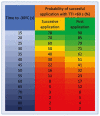Time to -30°C as a predictor of acute success during cryoablation in patients with atrial fibrillation
- PMID: 34708863
- PMCID: PMC10508066
- DOI: 10.5603/CJ.a2021.0135
Time to -30°C as a predictor of acute success during cryoablation in patients with atrial fibrillation
Abstract
Background: Freezing rate of second-generation cryoballoon (CB) is a biophysical parameter that could assist pulmonary vein isolation. The aim of this study is to assess freezing rate (time to reach -30°C ([TT-30C]) as an early predictor of acute pulmonary vein isolation using the CB.
Methods: Biophysical data from CB freeze applications within a multicenter, nation-wide CB ablation registry were gathered. Successful application (SA), was defined as achieving durable intraprocedural vein isolation. And SA with time to isolation under 60 s (SA-TTI<60) as achieving durable vein isolation in under 60 s. Logistic regressions were performed and predictive models were built for the data set.
Results: 12,488 CB applications from 1,733 atrial fibrillation (AF) ablation procedures were included within 27 centers from a Spanish CB AF ablation registry. SA was achieved in 6,349 of 9,178 (69.2%) total freeze applications, and SA-TTI<60 was obtained in 2,673 of 4,784 (55.9%) freezes where electrogram monitoring was present. TT-30C was shorter in the SA group (33.4 ± 9.2 vs 39.3 ± 12.1 s; p < 0.001) and SA-TTI<60 group (31.8 ± 7.6 vs. 38.5 ± 11.5 s; p < 0.001). Also, a 10 s increase in TT-30C was associated with a 41% reduction in the odds for an SA (odds ratio [OR] 0.59; 95% confidence interval [CI] 0.56-0.63) and a 57% reduction in the odds for achieving SA-TTI<60 (OR 0.43; 95% CI 0.39-0.49), when corrected for electrogram visualization, vein position, and application order.
Conclusions: Time to reach -30°C is an early predictor of the quality of a CB application and can be used to guide the ablation procedure even in the absence of electrogram monitoring.
Keywords: atrial fibrillation; atrial fibrillation ablation; cryoballoon ablation; pulmonary vein isolation; second-generation cryoballoon.
Conflict of interest statement
Figures






References
-
- Hindricks G, Potpara T, Dagres N, et al. 2020 ESC Guidelines for the diagnosis and management of atrial fibrillation developed in collaboration with the European Association for Cardio-Thoracic Surgery (EACTS): The Task Force for the diagnosis and management of atrial fibrillation of the European Society of Cardiology (ESC) Developed with the special contribution of the European Heart Rhythm Association (EHRA) of the ESC. Eur Heart J. 2021;42(5):373–498. doi: 10.1093/eurheartj/ehaa612. - DOI - PubMed
Publication types
MeSH terms
LinkOut - more resources
Full Text Sources
Medical

